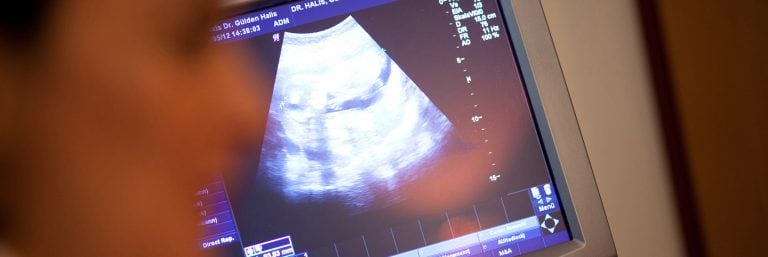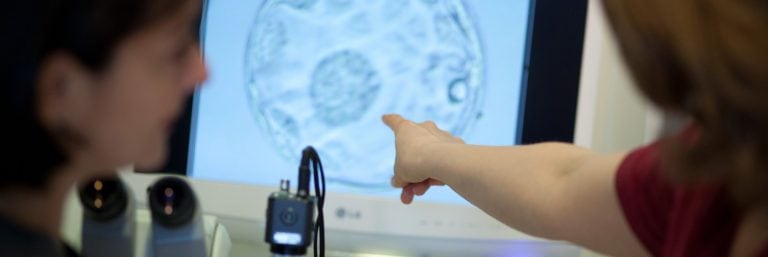Therapy of fibroids
It is always advisable to consider drug therapies before using invasive methods such as surgery (especially hysterectomy) or radiological procedures.
Medicinal treatment options are used for fibroids in order to
- reduce bleeding,
- control pain,
- stop fibroid growth
- and/or reduce fibroid size.
GnRH agonists (gonadotropin releasing hormone agonists)
GnRH analogues are administered as injections (e.g. leuprorelin, goserelin or triptorelin) or nasal sprays (buserelin) and inhibit the higher-level hormone production in the pituitary gland. This leads to a hypoestrogenic situation and clinically to a reversible type of “temporary menopause”. The myocytes (muscle cells) shrink, the fibroids shrink and the bleeding intensity decreases rapidly to the point of secondary amenorrhoea (cessation of bleeding). However, the lack of oestrogen also causes the corresponding vasomotor menopausal symptoms such as hot flushes, sweating, vaginal dryness, etc. The therapy is limited to 6 months without add-back.
Hormonal contraceptives and progestogens
In the case of small fibroids, attempts are often made to reduce symptoms such as bleeding intensity and menstrual pain with hormonal contraceptives (such as COC, hormonal IUD, 3-month injection). These medications are not approved by the authorities for the treatment of fibroids – therefore their use is considered an individual therapeutic trial (also called off-label use) and is not usually reimbursed by the health insurance funds. In the case of milder bleeding symptoms, their use as a primary therapy can be tried.
Experimental and complementary therapies
Complementary to the classical methods of orthodox medicine, acupuncture and homeopathy are also recommended. A study on the use of green tea extract was initiated at the Charité. The results are still pending.
Overview of drug therapy options
| GnRH | LNG-IUD (Hormon-Spirale) |
COC „Pille“ |
Gestagene | |
| Approval given? | ☺ | no | no | no |
| Causal treatment? | X | no | no | no |
| Long-term therapy possible? | X | ☺ | ☺ | ☺ |
| Bleeding control within | 7-14 days |
3-6 months |
1-2 months |
Dosis +Med-dependant |
| Success rate? | ☺ | ☺ ☺ | ☺ | ☺ ☺ |
| Volume reduction? | ☺ | no | no | no |
| Possible side effects? | All symptoms of menopause, renewed fibroid growth after therapy, intake limited to 6 months | Headaches, bleeding disorder | Headache Mastodynia | Acne, mood swings, libido, mastodynia |
| Contraceptive at the same time? | – | + | ☺ | +/– |
| Risk of thrombosis? | – | – | + | +/– |
Surgical myoma therapy
In general, fibroids should only be treated if they are symptomatic. Asymptomatic fibroids are not treated unless there is a “cancer scare”. You should be informed that different fibroid treatment options can affect fertility and the preservation of the uterus. In the past, when fibroids were diagnosed, the entire uterus was removed. Today, attempts are made to preserve the uterus in as individualized a way as possible. To do this, it can be helpful to treat the fibroids preoperatively with medication. Nevertheless, fibroids are still one of the most common indications for a hysterectomy (removal of the uterus). Hysterectomy should only be performed on women who have safely completed their family planning.
Removal of the fibroids (myoma enucleation or myoma resection)
In this surgical procedure, the fibroids are removed one by one and healthy tissue is not damaged if possible. The uterus itself remains intact. One advantage is the continued fertility if there is still a desire to have children. Myoma enucleation can be done in different ways:
- Laparoscopic (laparoscopy)
- Laparotomy (abdominal incision – if necessary also minilaparotomy) or
- In the course of a surgical hysteroscopy (without a creek incision).
Whether a myoma enucleation can be performed must be assessed individually and depends on the location, size and number of myomas.
Removal of the uterus (hysterectomy)
Removal of the uterus is still the most common surgical procedure for myoma therapy. This operation is often performed from the vagina (vaginal) or via laparoscopy. An open abdominal operation (laparotomy), also called abdominal hysterectomy, is rather rare nowadays, but may be necessary, for example, in the case of very large fibroids.
The advantage of removing the uterus is that the patient is symptom-free afterwards, especially the bleeding disorders are eliminated, and no more fibroids can appear.
After the removal of the uterus, pregnancy can no longer occur. This method is therefore not suitable for women with a current or future desire to have children. It is recommended to exhaust all other therapy options first.
Myoma embolisation or uterine artery embolisation (UAE)
In uterine artery embolisation (UAE), the blood vessels that supply the fibroid are closed. For this purpose, gelatine or plastic particles are injected into the uterine arteries via a catheter in the groin, thus causing an artificial occlusion. The blood supply to the fibroids is thus reduced or cut off, the fibroids can no longer grow and shrink within a few weeks or months.
When can a UAE be indicated?
For patients who are poorly suited for surgical procedures (incl. minimally invasive operations), e.g.
- high risk of surgery due to coagulation problems or internal diseases
- significant obesity (BMI 40)
- repeated surgical interventions in the lower and upper abdomen in the past
When can a UAE NOT be performed (so-called contraindication)?
- If you wish to have children
- During pregnancy
The procedure is generally performed by interventional radiologists. It is minimally invasive and effective in relieving symptoms. The fibroids can become smaller. The uterus is preserved.
Embolisation can be associated with pain during and after the procedure, so good pain management is part of the treatment. Revascularisation of the fibroids is possible. In Germany, family planning must be completed before the procedure.
Magnetic resonance imaging-guided focused ultrasound (MRgFUS)
The myoma can be heated to 55 – 90°C by the targeted concentration of ultrasound waves. Coagulation necroses develop. They are then degraded by the body’s own immune system within the following weeks and months. The treatment takes about three to four hours. The therapy is carried out on an outpatient or inpatient basis and is only applicable to selected myoma localisations and if the size is less than 10 cm. The costs are only covered by some health insurance companies.
There are no data on an interaction between drug therapy and MRgFUS treatment.
When can MRgFUS NOT be performed (so-called contraindication)?
- If you wish to have children
- During pregnancy
- If you have more than 5 fibroids
- In the case of fibroids with a diameter of more than 10 cm
- In case of contraindications to the contrast medium
Overview of further therapy options
| Methode | Art | Relevanz für Fertilität | Weitere Anmerkungen | |
| Minimally invasive / radiological procedures |
Uterine artery embolisation | radiological / minimally invasive | Uterus preservation, but loss of fertility cannot be ruled out | Recurrence of fibroids, pain, ovarian failure, high risks in subsequent pregnancy |
| MRgFUS | radiological / minimally invasive | no sufficient data | Can only be performed by specialised radiologists, insufficient long-term data, recurrence unclear | |
| Surgical procedures | Laparoscopic or open myoma enucleation (mini-laparotomy) | invasive | Fertility preservation possible | Recurrence of fibroids, post-operative risks, risk of adhesions Important if family planning has not yet been completed |
| Hysteroscopic myoma resection or hysteroscopic-assisted (targeted) curettage |
invasive | Fertility preservation | Post-operative risks, danger of intrauterine adhesions Important if family planning has not yet been completed |
|
| Vaginal myoma enucleation | invasive | Fertility preservation | Short-term and long-term complications, faster procedure compared to myoma enucleation, low blood loss, technical skill | |
| Vaginal hysterectomy with morcellement | invasive | No fertility preservation | Short-term and long-term complications, faster procedure compared to myoma enucleation, low blood loss, technical skill | |
| Laparoscopic-assisted or abdominal supracervical hysterectomy (LASH) | invasive | No fertility preservation | Short-term and long-term complications, faster procedure compared to myoma enucleation, less blood loss | |
| Laparoscopic or open hysterectomy (acetabular laparotomy or median lower abdominal laparotomy) | invasive | Loss of fertility | Short-term and long-term complications, faster procedure compared to myoma enucleation, low blood loss |




